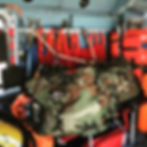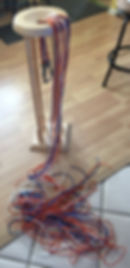What's a trice?
- Heidi Sather
- Jan 17, 2017
- 3 min read
Before we address that question let me present two of the primary culprits for any unexplained absences from my blog in the future:

I consider myself to have an above average vocabulary however, “trice” had not previously been in my wordy repertoire. I would cite Merriam Webster but since we are in a technologically advanced era I will cite www.merriam-webster.com.

I must applaud my husband for enriching my vocabulary with this term, as well as encouraging me to use paracord in Kumihimo. If you have not read my ABOUT page you may not know one of my many professions besides Pacific Patina owner and mom is Coastie Wife.

I’m very proud to say my husband is an AMT (Aviation Maintenance Technician) in the United States Coast Guard (USCG). One of my husband’s favorite responsibilities is being part of the flight crews that perform SAR (Search and Rescue) missions on the MH-60T: Jayhawk helicopters. In order to complete a successful hoist, one of his many duties is to ensure that all of his and the other crew members’ gear is safely stowed. Everything needs to be secured so it doesn’t move while in flight and out of the way so there is room for patients and to work. There can be a lot of gear to handle and he wanted a “clothesline” of sorts to be able to help easily and efficiently secure these necessary and often cumbersome supplies. He first became aware of his desire for this “clothesline” while in Alaska on long range SAR missions. During these, at times multi-day, missions the need to fly with an additional crew member (Health Services Technician) is often required and additional overnight bags and helmet bags are standard luggage in tight quarters.
My husband knew I made braids and he knew I could make a braid resembling the USCG racing stripe. Hence the USCG Gear Trice concept was conceived. Now to bring it to fruition…



You really cannot easily use a Kumihimo disk with over 100 feet of 550 paracord. Nor can you use 70 or 100g tama on the marudai. Time to procure 240g tama and do it without breaking the bank.
Another thanks is due to my husband and his collaboration on creating DIY 240g tama. Without him I don’t think my marudai would have ever been a heavyweight contender.
It turns out that 16 tama weighing 240g each need a fairly light 40% counterweight of 2.5lbs. to create a decently tight braid with 550 paracord. In corner #1 Heidi’s marudai weighing in at 18.6lbs!

The braiding is fast as it typically is on a marudai. The preparation and finishing work are where almost 2/3rds of the project time are spent on a gear trice.

After weaving back in 14 of the 16 elements nautical fusion comes in to play. Each gear trice I have braided is finished with coxcombing.


Coxcombing is an umbrella term for fancy knot work typically done on ships. To finish a USCG racing stripe gear trice I use simple spiral hitching (also known as French coxcomb) with a single orange and blue element. Where the two meet is covered with a Turk’s head knot. No two gear trice have been the same and I do not plan on replicating any single one. The Turk’s head knot is always distinct. Whether I use gutted paracord or not and the number of leads and bights always varies.


Recently I had a request from my husband to create a US flag gear trice. For this particular trice a core was utilized to achieve the change from red and white to white and blue.
I also decide to try my hand at a single strand ringbolt hitch was to finish. I’m sure this is one of many variations to come!










